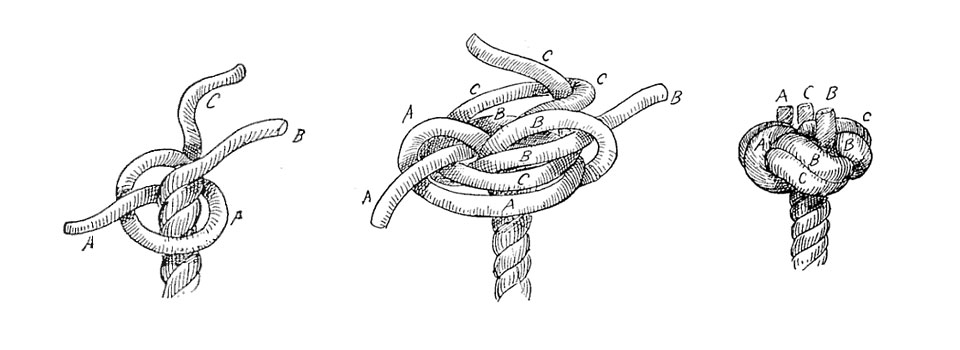A Guess-Me-Knot
2008
First, a short story:
Lever in 1808 speaks of “MATTHEW WALKER’S KNOT”. his familiar expression suggests that he may have known the inventor, who was possibly a master rigger in one of the British naval dockyards. Many myths have grown up around Matthew Walker, “the only man ever to have a knot named for him.” Dr. Frederic Lucas, of the American Museum of Natural History, once told me the following story of the Origin of the knot, which he had heard off the Chincha Islands while loading guano in 1869. A sailor, having been sentenced to death by a judge who in earlier life had been a sailor himself, was reprieved by the judge because of their common fellowship of the sea. The judge offered the sailor a full pardon if he could show him a knot that he, the judge, could neither tie nor untie. The sailor called for ten fathoms of rope and, having retired to the privacy of his cell, unlaid the rope halfway, put in a MATTHEW WALKER KNOT, and then laid up the rope again to the end. So Matthew Walker secured his pardon, and the world gained an excellent knot.
— from The Ashley Book of Knots
A Guess-Me-Knot is a musical account of this excellent tale. Imagine that each line of music you hear is a strand of rope. At first we hear only one such “strand”: the music does not work against itself. Then after a short time, the music splits into two, and you will hear what is referred to in the score as a “Two-Strand Knot”. The parts then re-unite, only to split again, this time into a more complicated "Four-Strand Knot". Finally, the music is reunited with itself.

As a musical representation of the “Matthew Walker Knot”, I have devised a contrapuntal technique which closely mirrors the direction and orientation of each strand of rope before, during, and after the successful execution of this tricky knot. The strand is initially the “right way up”; it then loops back upon itself; it then turns back again and ducks behind the other strands, and then loops through itself (which I have represented as a form of melodic inversion).
The result, I hope, is an interesting and humorous journey in musical counterpoint!
Duration
8 minutes
Instrumentation
flute, bass clarinet, violin, cello
First performance
25th May 2008, Purcell Room, Southbank Centre, London: Radius (Jennifer George, flute; Charys Green, bass clarinet; Alexandra Wood, violin; Oliver Coates, cello)
Request a score / parts
If you would like to see a score and/or require a set of parts for this music, please contact me.